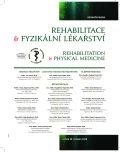Psoas Muscle and Possibilities to Influence It
Authors:
R. Bednár; G. Majeríková; S. Kušnierik
Authors‘ workplace:
Odd. FBLR, FNsP, F. D. Roosevelta, Banská Bystrica
primár MUDr. G. Majeríková
Published in:
Rehabil. fyz. Lék., 25, 2018, No. 1, pp. 16-21.
Category:
Original Papers
Overview
Psoas muscle is the largest and most powerful muscle, positioned on the ventral part of the spine. It is classified in lumbar joint flexors from the functional point of view. It is permanently overburdened in standing, walking and sitting position, and that is why tends to be shortened with results in increasing lumbar lordosis and increased load upon lumbar joints. In this way there is increasing tendency to wear out lumbar joints, which becomes manifest in limited internal rotation, shortened steps and first signs of coxarthrosis. In vertebrogenic syndromes in the shank area pain is often encountered. In practice its spasm and shortening play important roles. Our paper analyzed various approaches for treatment pf this muscle from the analytical exercise point of view as well as Spiral dynamics®, reflex creepage, or selected ásan from yoga. A correct diagnosis of affected psoas muscle and subsequent suitable therapy makes it possible to use various approaches for different patients. The more procedures are used, the broader spectrum of patients in different stages of the disease can be treated.
Keywords:
psoas muscle, exercise and psoas muscle, Spiral dynamic®, reflex creeping, The System Yoga in Daily Life
Sources
1. ČIHÁK, R.: Anatómie 1. Avicenum, Praha, 1987, s. 409.
2. HNÍZDIL, J., EMINGEROVÁ, D., NOVOTNÁ, J. et al.: Léčebné rehabilitační postupy Ludmily Mojžíšové. Grada, 1996, s. 136.
3 JANDA, V.: Funkční svalový test. Grada, 1996, s. 199-200.
4. JUKER, D., MC GILL, S. M., KROPF, P.: Elektromyograficky kontrolovaná studie na zdravých sportovcích za přesně definovaných zátěžových situací se zvláštím zřetelem na m. psoas a břišní svaly. Rehabilitace a fyzikální lékařství, 2, 1995, č. 4, s. 186-187.
5. KLÍMOVÁ, E, CVENGROŠOVÁ, A., MORVAY, P.: Absces musculli psoas – vlastné skúsenosti. Neurológia pre prax SD1, Martin, 2008, s. 33-34.
6. MAHEŠVARÁNANDA : Systém Joga v dennom živote. Ibera Verlag, Viedeň, 2000, s. 38.
7. NĚMCOVÁ, D., HOZA, J., DOLEŽALOVÁ, P.: Absces m. psoas major v diferenciální diagnostice bolestí zad. Česká revmatologie, 8, 2000, č. 1, s. 31.
8. TOMŠ, J., DVOŘÁK, P.: Kazustika: asymetrická bolesť v dolní části zad a hematom v musculus psoas při antiagregační terapii anopyrinem. Česká revmatologie, 10, 2002, č. 4, s. 183.
9. VÉLE, F.: Kineziologie. 2. vydanie, Triton, 2006, s. 241, 242, 248.
10. VOJTA, V., ANNERGET, P.: Vojtův princíp, Svalové souhry v reflexní lokomoci a motorické ontogeneze. Grada Publishing, s.r.o., 1995, s. 33.
Labels
Physiotherapist, university degree Rehabilitation Sports medicineArticle was published in
Rehabilitation and Physical Medicine

2018 Issue 1
Most read in this issue
- Psoas Muscle and Possibilities to Influence It
- Modern Manual Techniques the Treatment of Scars
- Treatment of Multiple Sclerosis from the Point of View of Rehabilitation
- Quality of Upper Extremity Skills Test: Practical Utility in Occupational Therapy in Children with Cerebral Palsy
